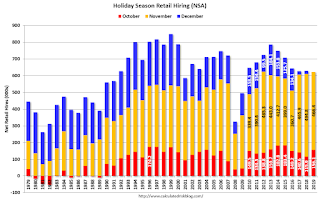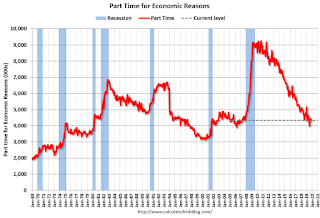by Calculated Risk on 12/06/2019 09:20:00 AM
Friday, December 06, 2019
Comments on November Employment Report
The headline jobs number at 266 thousand for November was above consensus expectations of 180 thousand, and the previous two months were revised up 41 thousand, combined. The unemployment rate decreased to 3.5%.
Earlier: November Employment Report: 266,000 Jobs Added, 3.5% Unemployment Rate
In November, the year-over-year employment change was 2.204 million jobs including Census hires.
Seasonal Retail Hiring
Typically retail companies start hiring for the holiday season in October, and really increase hiring in November. Here is a graph that shows the historical net retail jobs added for October, November and December by year.

This graph really shows the collapse in retail hiring in 2008. Since then seasonal hiring has increased back close to more normal levels. Note: I expect the long term trend will be down with more and more internet holiday shopping.
Retailers hired 466 thousand workers (NSA) net in November. Note: this is NSA (Not Seasonally Adjusted).
In October and November combined, retailers hired about the same number of seasonal workers as in the previous two years.
Average Hourly Earnings
Wage growth was below expectations. From the BLS:
"In November, average hourly earnings for all employees on private nonfarm payrolls rose by 7 cents to $28.29. Over the last 12 months, average hourly earnings have increased by 3.1 percent."
 This graph is based on “Average Hourly Earnings” from the Current Employment Statistics (CES) (aka "Establishment") monthly employment report. Note: There are also two quarterly sources for earnings data: 1) “Hourly Compensation,” from the BLS’s Productivity and Costs; and 2) the Employment Cost Index which includes wage/salary and benefit compensation.
This graph is based on “Average Hourly Earnings” from the Current Employment Statistics (CES) (aka "Establishment") monthly employment report. Note: There are also two quarterly sources for earnings data: 1) “Hourly Compensation,” from the BLS’s Productivity and Costs; and 2) the Employment Cost Index which includes wage/salary and benefit compensation.The graph shows the nominal year-over-year change in "Average Hourly Earnings" for all private employees. Nominal wage growth was at 3.1% YoY in November.
Wage growth had been generally trending up, but has weakened recently.
Prime (25 to 54 Years Old) Participation
 Since the overall participation rate has declined due to cyclical (recession) and demographic (aging population, younger people staying in school) reasons, here is the employment-population ratio for the key working age group: 25 to 54 years old.
Since the overall participation rate has declined due to cyclical (recession) and demographic (aging population, younger people staying in school) reasons, here is the employment-population ratio for the key working age group: 25 to 54 years old.In the earlier period the participation rate for this group was trending up as women joined the labor force. Since the early '90s, the participation rate moved more sideways, with a downward drift starting around '00 - and with ups and downs related to the business cycle.
The 25 to 54 participation rate was unchanged in November at 82.8%, and the 25 to 54 employment population ratio was unchanged at 80.3%.
Part Time for Economic Reasons
 From the BLS report:
From the BLS report:"The number of persons employed part time for economic reasons, at 4.3 million, changed little in November. These individuals, who would have preferred full-time employment, were working part time because their hours had been reduced or they were unable to find full-time jobs."The number of persons working part time for economic reasons decreased in November to 4.332 million from 4.438 million in October. The number of persons working part time for economic reason has been generally trending down.
These workers are included in the alternate measure of labor underutilization (U-6) that decreased to 6.9% in November.
Unemployed over 26 Weeks
 This graph shows the number of workers unemployed for 27 weeks or more.
This graph shows the number of workers unemployed for 27 weeks or more. According to the BLS, there are 1.224 million workers who have been unemployed for more than 26 weeks and still want a job. This was down from 1.264 million in October.
Summary:
The headline jobs number was above expectations, and the previous two months were revised up. The headline unemployment rate decreased to 3.5%; however, wage growth was below expectations. Overall this was a solid report.
Note> The conclusion of the GM strike boosted employment in November, after negatively impacting employment in October.
In 2019, the economy has added 1.969 million jobs through November 2019 ex-Census, down from 2.452 million jobs during the same period of 2018 (although 2018 will be revised down with benchmark revision to be released in February 2020). So job growth has slowed.


